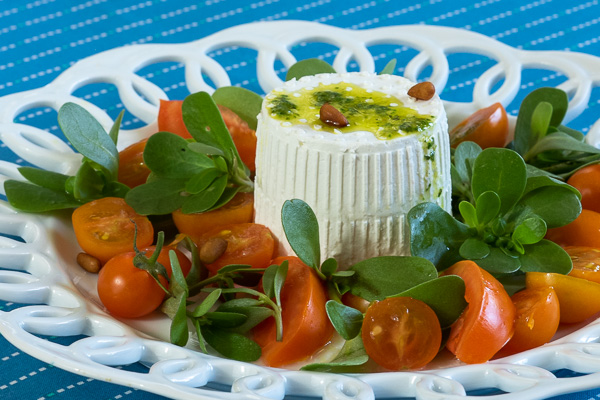I hope I live long enough to see American-made water buffalo cheese at every cheese counter, but it’s not looking good. One step forward, two steps back. Someone starts a water buffalo dairy, another fails. I dream of homegrown mozzarella di bufala, of course. But Italian cheesemakers do so much more with this super-rich milk. The gorgeous, slumpy cheese pictured above demonstrates what water buffalo milk can do in skilled hands. Will we ever get there?
Read moreSuperstar New Cheeses from Europe
“How many cheeses do you have to eat to become a cheese expert?” someone asked me recently. As if there’s a checklist. I’m not counting, but I did add several remarkable new cheeses to my life list last week. I led a tasting of “New Arrivals from Europe,” including the beauty pictured above, and I was blown away by these newcomers.
Read moreSmall but Mighty
Italian tradition. Canadian milk. American persistence. Calabro Cheese’s ricotta di bufala required input from three countries and a decade of effort before the Connecticut company had a viable product. The cheese now has earned multiple ribbons from the American Cheese Society and is poised for takeoff. Like other water-buffalo cheeses, Calabro ricotta di bufala is not inexpensive (I paid $3.49 for a four-ounce basket), but if successful, it may persuade others to ponder the potential for water buffalo in the U.S. We can hope.
Read moreBuffalo Stampede
You’re not imagining it. Buffalo are roaming all over American cheese counters these days. Buffalo ricotta, mozzarella, Camembert, blue. I haven’t spotted a buffalo Cheddar yet, but surely any day now. From a curiosity to (almost) mainstream in a decade, cheese made with rich water-buffalo milk is having its moment. Many are good; a few are great.
Read moreTop of the Mountain
Cheese champ: Chris Roelli
For cheesemaker Chris Roelli, last week’s American Cheese Society “Best of Show” ribbon must feel like sweet vindication. Roelli spent years trying to persuade his father to get back in the business after the elder Roelli shuttered his Wisconsin cheese plant in 1991. The family had struggled to make a living producing commodity Cheddar and other low-priced cheese—the type that ends up shredded on a fast-food taco. “When we closed the doors, we were making literally a penny a pound,” Chris told me.
Read more




